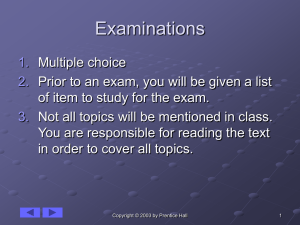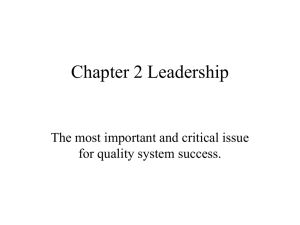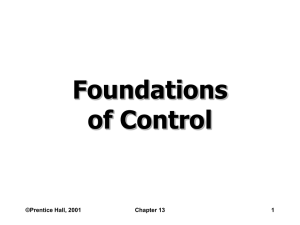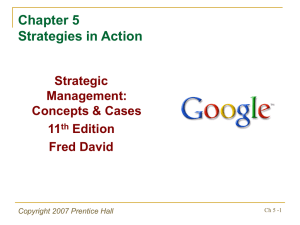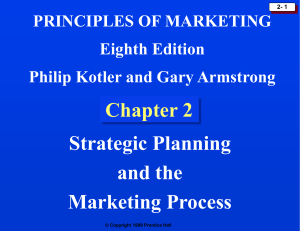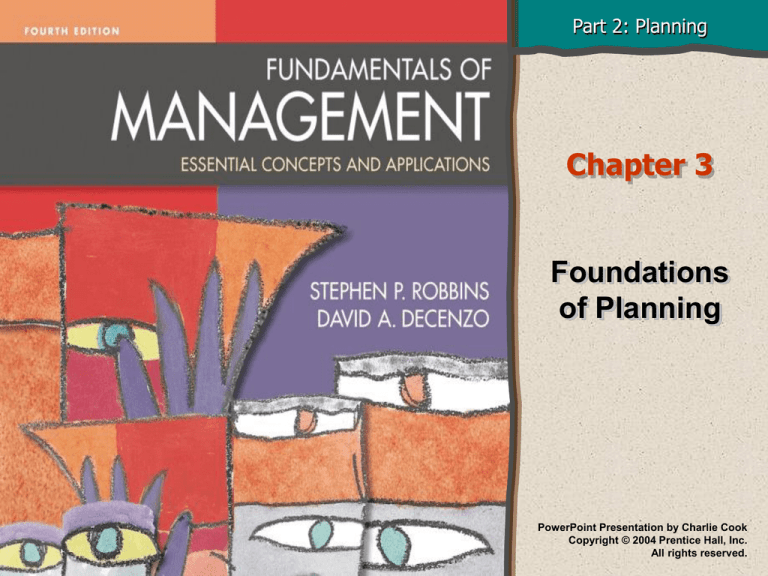
Part 2: Planning
Chapter 3
Foundations
of Planning
PowerPoint Presentation by Charlie Cook
Copyright © 2004 Prentice Hall, Inc.
All rights reserved.
LEARNING OUTCOMES
After reading this chapter, I will be able to:
1. Define planning.
2. Explain the potential benefits of planning.
3. Identify potential drawbacks to planning.
4. Distinguish between strategic and tactical
plans.
5. Recognize when directional plans are preferred
over specific plans.
6. Define management by objectives and identify
its common elements.
Copyright © 2004 Prentice Hall, Inc. All rights reserved.
3–2
L E A R N I N G O U T C O M E S (cont’d)
After reading this chapter, I will be able to:
7. Outline the steps in the strategic management
process.
8. Describe the four grand strategies.
9. Explain SWOT analysis.
10. Describe how entrepreneurs identify a
competitive advantage.
Copyright © 2004 Prentice Hall, Inc. All rights reserved.
3–3
Planning Defined
• Defining the organization’s objectives or goals
• Establishing an overall strategy for achieving
those goals
• Developing a comprehensive hierarchy of plans
to integrate and coordinate activities
Planning is concerned with ends (what is to be done)
as well as with means (how it is to be done).
Copyright © 2004 Prentice Hall, Inc. All rights reserved.
3–4
Reasons for
Planning
EXHIBIT 3.1
Copyright © 2004 Prentice Hall, Inc. All rights reserved.
3–5
Criticisms Of Formal Planning
• Planning may create rigidity.
• Plans can’t be developed for a dynamic
environment.
• Formal plans can’t replace intuition and
creativity.
• Planning focuses managers’ attention on today’s
competition, not on tomorrow’s survival.
• Formal planning reinforces success, which may
lead to failure.
Copyright © 2004 Prentice Hall, Inc. All rights reserved.
3–6
Planning and Performance
• Formal planning generally means higher profits,
higher return on assets, and other positive
financial results.
• Planning process quality and implementation
probably contribute more to high performance
than does the extent of planning.
• When external environment restrictions allowed
managers few viable alternatives, planning did
not lead to higher performance.
Copyright © 2004 Prentice Hall, Inc. All rights reserved.
3–7
Types of Plans
BREADTH
OF USE
TIME
FRAME
SPECIFICITY
FREQUENCY
OF USE
Strategic
Long term
Directional
Single use
Tactical
Short term
Specific
Standing
EXHIBIT 3 .2
Copyright © 2004 Prentice Hall, Inc. All rights reserved.
3–8
Planning: Focus and Time
• Strategic plans
Plans that are organization-wide, establish overall
objectives, and position an organization in terms of its
environment
• Tactical plans
Plans that specify the details of how an organization’s
overall objectives are to be achieved
• Short-term plans
Plans that cover less than one year
• Long-term plans
Plans that extend beyond five years
Copyright © 2004 Prentice Hall, Inc. All rights reserved.
3–9
Strategic Planning
• Strategic plans
Apply broadly to the entire organization
Establish the organization’s overall objectives
Seek to position the organization in terms of its
environment
Provide direction to drive an organization’s efforts to
achieve its goals.
Serve as the basis for the tactical plans.
Cover extended periods of time
Are less specific in their details
Copyright © 2004 Prentice Hall, Inc. All rights reserved.
3–10
Tactical Planning
• Tactical plans (operational plans)
Apply to specific parts of the organization.
Are derived from strategic objectives
Specify the details of how the overall objectives are to
be achieved.
Cover shorter periods of time
Must be updated continuously to meet current
challenges
Copyright © 2004 Prentice Hall, Inc. All rights reserved.
3–11
Directional versus Specific Plans
EXHIBIT 3 .3
Copyright © 2004 Prentice Hall, Inc. All rights reserved.
3–12
Specific and Directional Plans
• Specific plans
Plans that have clearly defined objectives and leave
no room for misinterpretation
“What,
when, where, how much, and by whom”
(process-focus)
• Directional plans
Flexible plans that set out general guidelines
“Go
from here to there” (outcome-focus)
Copyright © 2004 Prentice Hall, Inc. All rights reserved.
3–13
Single-Use and Standing Plans
• Single-use plans
A plan that is used to meet the needs of a particular
or unique situation
Single-day
sales advertisement
• Standing plan
A plan that is ongoing and provides guidance for
repeatedly performed actions in an organization
Customer
satisfaction policy
Copyright © 2004 Prentice Hall, Inc. All rights reserved.
3–14
Management by Objectives
• Management by Objectives (MBO)
A system in which specific performance objectives are
jointly determined by subordinates and their
supervisors, progress toward objectives is periodically
reviewed, and rewards are allocated on the basis of
that progress.
Links individual and unit performance objectives at all
levels with overall organizational objectives
Focuses operational efforts on organizationally
important results.
Motivates rather than controls
Copyright © 2004 Prentice Hall, Inc. All rights reserved.
3–15
Cascading of Objectives
EXHIBIT 3.4
Copyright © 2004 Prentice Hall, Inc. All rights reserved.
3–16
Elements of MBO
• Goal specificity
• Participative decision making
• Explicit time period for performance
• Performance feedback
Copyright © 2004 Prentice Hall, Inc. All rights reserved.
3–17
Setting Employee Objectives
• Identify an employee’s key job tasks.
• Establish specific and challenging goals for each
key task.
• Allow the employee to actively participate.
• Prioritize goals.
• Build in feedback mechanisms to assess goal
progress.
• Link rewards to goal attainment.
Copyright © 2004 Prentice Hall, Inc. All rights reserved.
3–18
Strategic Management
• Strategic Management Process
A nine-step process that involves strategic planning,
implementation, and evaluation
• The organization’s current identity
Mission statement
Defines
the purpose of the organization
Objectives
Strategic plan
A document
that explains the business founders vision
and describes the strategy and operations of that
business.
Copyright © 2004 Prentice Hall, Inc. All rights reserved.
3–19
The Strategic Management Process
EXHIBIT 3.5
Copyright © 2004 Prentice Hall, Inc. All rights reserved.
3–20
Analyze the Environment
• Environmental scanning
Screening large amounts of information to detect
emerging trends and create a set of scenarios
• Competitive intelligence
Accurate information about competitors that allows
managers to anticipate competitors’ actions rather
than merely react to them
Copyright © 2004 Prentice Hall, Inc. All rights reserved.
3–21
SWOT: Identifying
Organizational
Opportunities
SWOT analysis
Analysis of an organization’s strengths,
weaknesses, opportunities, and threats in
order to identify a strategic niche that the
organization can exploit
EXHIBIT 3.6
Copyright © 2004 Prentice Hall, Inc. All rights reserved.
3–22
SWOT Analysis
• Strengths (strategic)
Internal resources that are available or things that an
organization does well
Core competency: a unique skill or resource that
represents a competitive edge
• Weaknesses
Resources that an organization lacks or activities that it
does not do well
• Opportunities (strategic)
Positive external environmental factors
• Threats
Negative external environmental factors
Copyright © 2004 Prentice Hall, Inc. All rights reserved.
3–23
Grand Strategies
• Growth strategy
A strategy in which an organization attempts to increase the
level of its operations;
• Retrenchment strategy
A strategy characteristic of a company that is reducing its
size, usually in an environment of decline
• Combination strategy
The simultaneous pursuit by an organization of two or more
of growth, stability, and retrenchment strategies
• Stability strategy
A strategy that is characterized by an absence of significant
change
Copyright © 2004 Prentice Hall, Inc. All rights reserved.
3–24
Growth Strategies
• Merger
Occurs when two companies, usually of similar size,
combine their resources to form a new company
• Acquisition
Occurs when a larger company buys a smaller one
and incorporates the acquired company’s operations
into its own
Copyright © 2004 Prentice Hall, Inc. All rights reserved.
3–25
Competitive Strategies
• Strategies that position an organization in such a
way that it will have a distinct advantage over its
competition
Cost-leadership strategy
Becoming
the lowest-cost producer in an industry
Differentiation strategy
Attempting
to be unique in an industry within a broad
market
Focus strategy
Attempting
to establish an advantage
(cost/differentiation) in a narrow market segment
Copyright © 2004 Prentice Hall, Inc. All rights reserved.
3–26
Benchmarking
• Benchmarking
The search for the best practices among competitors
or noncompetitors that lead to their superior
performance
• ISO 9000 series
Standards designed by the International Organization
for Standardization that reflect a process whereby
independent auditors attest that a company’s factory,
laboratory, or office has met quality management
standards
Copyright © 2004 Prentice Hall, Inc. All rights reserved.
3–27
Attaining Six Sigma Quality
• Six sigma
A philosophy and measurement process developed in
the 1980s at Motorola.
To design, measure, analyze, and control the input
side of a production process to achieve the goal of no
more than 3.4 defects per million parts or procedures.
A philosophy and measurement process that attempts
to design in quality as a product is being made.
Copyright © 2004 Prentice Hall, Inc. All rights reserved.
3–28
Six Sigma 12-Process Steps
• Select the critical-to-quality characteristics.
• Define the required performance standards.
• Validate measurement system, methods, and procedures.
• Establish the current processes capability.
• Define upper and lower performance limits.
• Identify sources of variation.
• Screen potential causes of variation to identify the vital few variables
needing control.
• Discover variation relationship for the vital variables.
• Establish operating tolerances on each of the vital variables.
• Validate the measurement system’s ability to produce repeatable data.
• Determine the capability of the process to control the vital variables.
Implement statistical process control on the vital variables.
Source: Cited in D. Harold and F. J. Bartos, “Optimize Existing Processes to Achieve Six Sigma Capability,”
reprinted with permission from Control Engineering, March 1998, p.87, © Cahners Business Information.
Copyright © 2004 Prentice Hall, Inc. All rights reserved.
EXHIBIT 3.7
3–29
Identifying A Competitive Advantage
• Environmental sources of entrepreneurial
opportunity
The unexpected
The incongruous
The process need
Industry and market structures
Demographics
Changes in perception
New knowledge
Copyright © 2004 Prentice Hall, Inc. All rights reserved.
3–30

